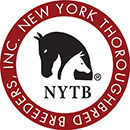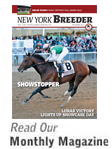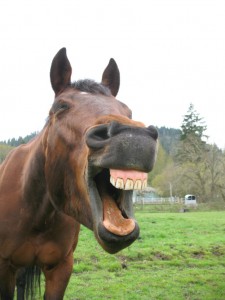By Tom Gallo
Hello fellow New York Breeders. We have something new for you this week: A new section of our popular NYTB e-newsletter entitled “Straight from the Horse’s Mouth.” This series, also to be published on the NYTB website, will be short question and answer articles on subjects relevant and time-sensitive to all aspects of breeding and raising Thoroughbreds. We hope you will enjoy this new section and we plan to continue this series throughout the year.
Here’s to a productive and successful breeding season!
As always; have a Winning Day!!
Tom Gallo
President NYTB
This week we will be hearing from one of our NYTB Board members Mr. Wally Burleson General Manager of Sequel Stallions in Hudson NY.
Mr. Burleson is a third generation horseman and native Texan, with a long history of ranching and raising Quarter Horse and Thoroughbred Bloodstock. He and his brother literally grew up on the back of a horse either working the ranch or in an arena. This desire led him to study Equine Science at Tarleton State University and ultimately led him to Central Kentucky. He is kind enough to give us his time and expertise regarding the comings and goings of one of the premier breeding sheds in the state of New York, Sequel Stallions.
- Wally, what are some of the basics you require before you are comfortable breeding a mare to one of your stallions?
Of course to start off with we need a signed breeding contract for your mare, signed, sealed and delivered. Also, we will need a Mare Information Form, as well as the Breeding Shed Form provided with your contract on file or accompanying your mare. Your mare must have the proper identification for her visit to our breeding shed. A negative uterine culture for maiden, barren and second-trip foaling mares is required. Don’t forget, an up to date coggins (2016) is a must!
All this information and proper forms are on our website or available from our booking secretary. We can, and are happy to, assist with any and all of this other than your veterinarian’s certificate for a negative uterine culture which only they can provide. Be sure to check with the specific breeding shed you are visiting as these requirements may vary.
- Do you treat maiden mares differently than you would foaling mares?
Without a doubt, we do treat maiden mares differently. This is a completely new experience for them. We always look out for the best interest of our crew, stallions, mares, and everyone involved in the breeding process. Maidens are required to have the proper paperwork and identification, as well as a negative uterine culture. They must also be jumped prior to their visit to the breeding shed. We are obviously going to jump them ourselves to see how receptive the mare is for the safety of our stallions and all involved. Some farms may not have a teaser and aren’t able to jump them prior to their visit and that’s okay, however communication is crucial. Please let the stallion manager know one way or the other.
- How can you be sure that the mare is who she says she is?
So long as she is presented with proper identification (name plate on halter, name plate on neck strap), it’s not a problem. When they show up without proper identification for whatever reason we need a current Coggins to confirm markings and a tattoo if applicable. We also get confirmation from owners or agents. If this information is not available, then unfortunately, we can not breed the mare.
- How do you feel about bringing foals along with the mares?
To each is own, here everyone has their own theory. Personally I would not; mares are quieter when they are away from their foals and it’s safer for all. Every circumstance is different and many breeders travel a long way; therefore, we will accommodate however necessary. However, if they show up with their foal, we unload the mare and send the van driver down the road for coffee with the foal. This will allow the mare to settle and focus on what’s ahead. We then give the driver a call when the mare has been covered to return and pick the mare up.
- How early/what’s the best time for a person to call to book their mare to one of your stallions?
Early is always better in order for us to accommodate everyone the best we can. Getting your mare on the stallion’s book early in her cycle (heat period) makes it easier to accommodate everyone. It’s in everyone’s best interest to get the mares covered when they need to be bred so they have the best opportunity to get in foal and not have to return. Obviously, Mother Nature plays a role in this and the mares themselves don’t always read the book so to speak in terms of their cycles etc.! So if you can’t book early, do the best you can and we will do our best to accommodate you.
- How important is it to get there on time?
It’s important because these stallions have scheduled breedings multiple times a day. If one mare arrives late it pushes everything back for that stallion for the rest of the day. Stallions need a few hours rest between breedings. Everyone does the best they can and uncontrollable circumstances do happen. That’s all well and fine as long as there is communication; then we can all adjust accordingly.
- Is it really that big a difference between a morning, mid-day, or afternoon breeding?
That is debatable and depends on your veterinarian. The way we check and set up our mares on the farm, I’m good for whatever time slot I get on the preferred day. Of course as stated earlier, there are circumstances where a mare may dictate differently and we adjust accordingly.
- After the mare leaves the breeding shed, what kind of communication do you expect from the mare owner down the road/subsequent days and weeks following her cover by your stallion?
We love to know when their mare is pronounced in foal; those are the best calls versus calling for a return visit, which in this business happens to all of us. They don’t have to call every time they ultrasound their mare, just when they can give us the mare’s status.
- What other tips can you recommend for a mare owner to get their mare in foal?
Do your homework when making decisions with boarding farms and veterinarians. It’s a team effort between all. Everyone’s goal should be to get live healthy foals on the ground, raise them to be healthy and athletic, and get mares bred back and in foal to top New York sires in a timely fashion.
- What’s your pet peeves when it comes to dealing with mare owners?
Personally, I really don’t have any major peeves. I guess one is when new owners are not well-informed and may not know the drill. They should speak with those that are more seasoned and experienced, and have been doing this for a while. So long as there is good communication, honesty, and integrity it generally works out.
- What’s your greatest experience with mare owners?
To hear their appreciation and gratitude for any assistance provided that helped them achieve their goals whether on the farm, racetrack, or in the sales arena.
*
Thank you, Wally for this helpful information. I am sure people will use these tips to be better prepared and have a positive all-around breeding experience thanks to your insight and candor.
Watch for more helpful interviews and save the date for our next LIVE Educational Seminar on April 30 at the Fasig-Tipton pavilion!
If you have any questions for Mr. Burleson or comments, questions, feedback or suggestions for future dialogue, feel free to email them to: info@nytbreeders.org — TG










